A Caribbean island gets everyone involved in protecting beloved species
Tiny Saba has a wealth of beloved species in need of support

The Caribbean island of Saba has one volcano, one major road and a wealth of biodiversity. Some of its hallmark species are declining, and scientists are enlisting residents to help keep an eye on them.
FRANS LEMMENS/CORBIS DOCUMENTARY/GETTY IMAGES PLUS
The coral reef, once bustling with more than 5,000 long-spined sea urchins, became a ghost town in a matter of days. White skeletons with dangling spines dotted the reef near the Dutch Caribbean island of Saba, the water cloudy from the disintegrating corpses. In just a week last April, half of the urchins, Diadema antillarum, in a section of reef called “Diadema City” had died. In June, only 100 remained.
The mysterious die-off started sweeping across the Caribbean in February. It’s eerily similar to a mass mortality event in 1983 that wiped out as much as 99 percent of the Caribbean Diadema population — a huge blow to not only the urchins, which have not fully recovered four decades later, but also the reefs. Without urchins grazing, algae can overwhelm a reef, damaging adult coral and leaving nowhere for new coral to settle.
Before the die-off, Saba’s coral cover — the part of a reef that consists of live hard coral rather than sponges, algae or other organisms — hovered around 50 percent. Today, that number is down to 3 percent.
“It’s just downhill, downhill, downhill,” says Alwin Hylkema, a marine ecologist at Van Hall Larenstein University of Applied Sciences and Wageningen University in the Netherlands who is based in Saba (pronounced “say-bah”).
I learned about Saba’s sea urchin problem only shortly after I learned that the island existed. Saba is a blip in the Caribbean; at 13 square kilometers, it’s about a quarter the size of Manhattan, with the towering Mount Scenery volcano at its center. Its reefs attract scuba divers, but a lack of beaches shields it from regular Caribbean tourist traffic — hence its nickname, “the unspoiled queen.” What the island lacks in size and sand it makes up for with its great variety of species, its biodiversity. Steep cliffs support several microclimates. In just a few hours, a visitor can hike from volcanic rock to grassy field to misty cloud forest.
This diversity makes Saba the perfect spot for Sea & Learn, an annual educational program that brings scientists from around the world to the island. Former dive shop owner Lynn Costenaro launched the program in 2003 to encourage more divers to visit Saba during the off-season. But the event has grown to play an important role in educating the island’s 2,000 residents about their home’s unique wildlife and ecosystems.
Throughout October, the scientists present their research on everything from biology and geology to astronomy at restaurants and in plazas. Several researchers also host public research trips underwater and on shore, so attendees can see the lobsters, or rock formations or stars for themselves.
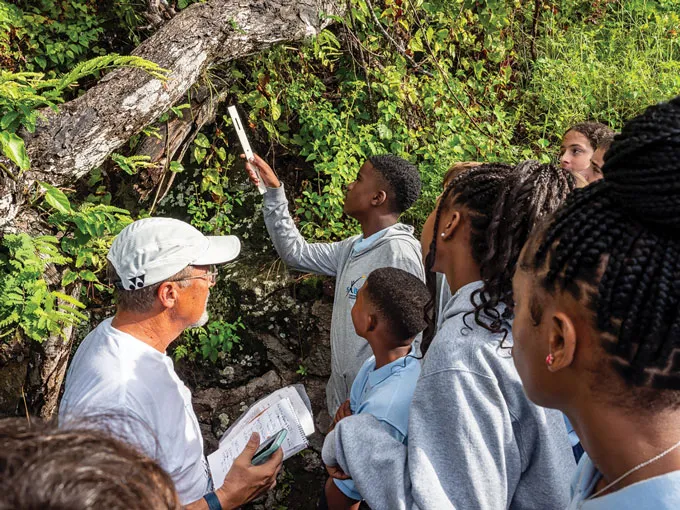
This kind of local engagement with the environment comes at a time when many species are at risk, and not just on Saba, says Severin Irl, an island ecologist at Goethe University Frankfurt in Germany. Although islands cover only about 7 percent of the world’s landmass, they are home to an estimated 20 percent of all species — and 75 percent of all documented extinctions.
Some island species occupy only one island; others are spread out in small populations across several islands. Species within small populations can develop a very narrow, island-specific set of adaptations, which spells trouble when humans and invasive species arrive. Today, any given plant or animal on an island is 12 times as likely to go extinct as species on the mainland, Irl and an international group of researchers reported in the November 2021 Global Ecology and Conservation. And the decline is speeding up at an unprecedented rate. As biodiversity decreases, islands lose the complexity that helps keep the ecosystem stable and less vulnerable to disruptions, such as climate change.
“We’re in the midst of a biodiversity crisis … and islands are really bearing the brunt of that global change,” says arachnologist Lauren Esposito of the California Academy of Sciences, who has presented research on spiders and scorpions at Sea & Learn.
The features that put island inhabitants at risk — their small size and isolation — also make them wonderful laboratories. Like the famous Galápagos Islands that turned Charles Darwin on to natural selection, islands present opportunities to study individual species as well as ecosystem dynamics, in a relatively small microcosm. In 2021, the California Academy of Sciences launched Islands 2030, co-led by Esposito, in five tropical archipelagos, including the Lesser Antilles where Saba is located. The aim is to conduct biodiversity research as well as train local communities to become guardians of their environments. The program took its inaugural trip to Saba’s Sea & Learn last October.
I attended that Sea & Learn and tagged along on field trips to see what progress and pitfalls researchers had experienced while working on Saba to protect a tiny orchid, a bright-billed bird and those dying urchins.
Counting orchids
On my first night, I joined locals and tourists at the Brigadoon restaurant to hear Mike Bechtold talk about Saba’s orchids. Bechtold, a retired nuclear arms expert from Virginia who fell in love with orchids while serving in Korea, first traveled to the island in 2003 to study the flowers. He’s since presented several times at Sea & Learn. This was his first time back in seven years.
After defining an orchid as a flowering plant with three petals and a laundry list of unusual attributes, Bechtold described the disorganized history of orchid research on Saba, including a series of miscommunications that has resulted in count discrepancies. A recently published book identifies 22 species, while Bechtold counts 32.
“To know what we have to preserve, well, we at least have to know what is there,” says Michiel Boeken, a former secondary school teacher from the Netherlands who studied orchids on Saba during his 2010 to 2012 tenure as principal of the island’s only secondary school.
The morning after his presentation, Bechtold led a hike to Spring Bay to look for orchids. We walked along the island’s only major road — aptly named The Road. At the trailhead, we descended into a swath of trees laden with mosses and other plants. We’d only walked for about 10 minutes when Bechtold pointed out an Epidendrum ciliare, the most common orchid on Saba, perched on a tree.
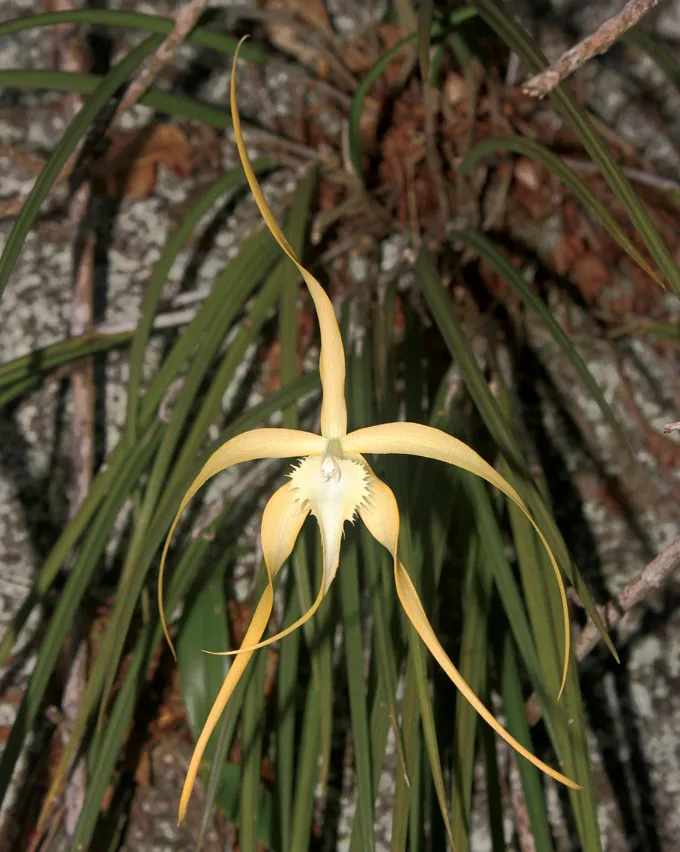
Stepping carefully over hermit crabs, we looked for the pile of rocks that marked where to leave the trail to find another species, Brassavola cucullata. Bechtold, Boeken and colleagues had surveyed the Spring Bay population from 2011 to 2014 to see if Saba’s numbers were declining. As we lowered ourselves down the steep hillside, we eventually spied the tiny white and yellow flowers of B. cucullata atop a tall tree with a metal tag glued beneath it; it was #582 of 834 B. cucullata plants that Bechtold helped tag a decade earlier.
We counted the plant’s leaves and measured them. Bechtold’s team had found that larger plants with more leaves had a better chance of survival than smaller plants, as did plants that were higher off the ground, like #582. Plants close to the ground were often munched on by wild goats.
The orchid is found from Mexico to northern South America. But here, the B. cucullata population was indeed declining, with small plants dying and not many new plants starting to grow, the researchers reported in 2020 in the International Journal of Plant Sciences. Without counting flowers for many more years, if not decades, it will be hard to know if the decline reflects natural population dynamics or if it’s a troublesome trend.
Regardless of cause, the population’s small size makes the island’s B. cucullata vulnerable. A recent hurricane knocked over several trumpet trees hosting large orchid plants. Some of the plants were crushed; others, lowered to the ground when their tree toppled, faced death by goat chomping.
Tracking red-billed tropicbirds
A week after the orchid hike, I found myself perched on a boulder high up on a cliff at Tent Bay on the island’s southern coast, looking for nests tucked into narrow rock crevices. German ecologist Lara Mielke, another volunteer and I started out at dawn to beat the heat, climbing hand over foot up the exposed hill. Overhead, red-billed tropicbirds, with long white tails and bright crimson beaks, swooped out across the sea.
About 1,500 breeding pairs of Phaethon aethereus mesonauta, one of the three subspecies of red-billed tropicbirds, breed on Saba, as much as a quarter of the subspecies’s global population. Tropicbirds spend most of their lives at sea, only coming to land for a few months each year to breed and raise a single chick. Their cliffside nesting spot makes the birds hard to study even when they’re on land. Fortunately, on Saba and the neighboring island Saint Eustatius, or “Statia,” the terrain is tough but not impossible to scale.
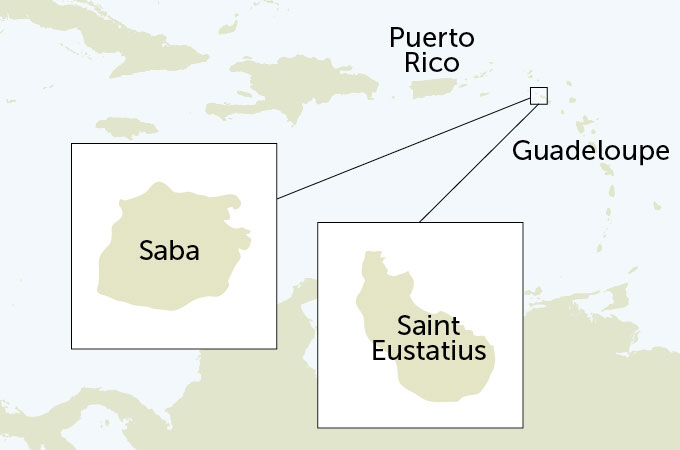
While climbing, I was startled by an abrasive squawk coming from a deep crevice hiding a nest. But the birds are more squawk than bite, and Mielke was able to reach her arm into the small opening and extract the bird to wrap a band around its leg.
Tameness, helpful when it comes to banding, makes these birds vulnerable to invasive predators. Tropicbird chicks are often eaten by feral cats that roam the island’s cliffs. Over the years, the Saba Conservation Foundation has set up cat eradication programs with mixed success.
After banding the bird, Mielke handed me a warm egg she’d pulled from the nest. I held it in my palm as she filled a plastic bin with water. An egg’s buoyancy indicates how far along it is. We knew, though, that once the chick hatched, it probably wouldn’t live long. In past years, researchers have observed the disappearance of every chick at Tent Bay, presumably snatched by the feral cats.
Chicks have much better odds on the other side of the island. In 2011 and 2012, Boeken — involved in several conservation efforts on Saba — found that 62 of 83 hatchlings, or 75 percent, at Old Booby Hill near Spring Bay to the north survived to fledge the nest. And on Statia, which has no cat problem, as many as 90 percent of chicks survive after they’ve hatched. Though, for reasons still unknown, their colonies produce much fewer chicks because many eggs simply never hatch.
Tropicbirds are faithful to both their mate and nest site, sometimes even returning to the same rock cavity each year, says ecologist Hannah Madden of the Caribbean Netherlands Science Institute, who moved from the Netherlands to Statia in 2006 and has spearheaded Statia and Saba’s tropicbird research. But the birds may be loyal to a fault. If a nest is repeatedly robbed or eggs fail to hatch, the chances of successfully raising chicks may be increased by relocating or finding a new mate.
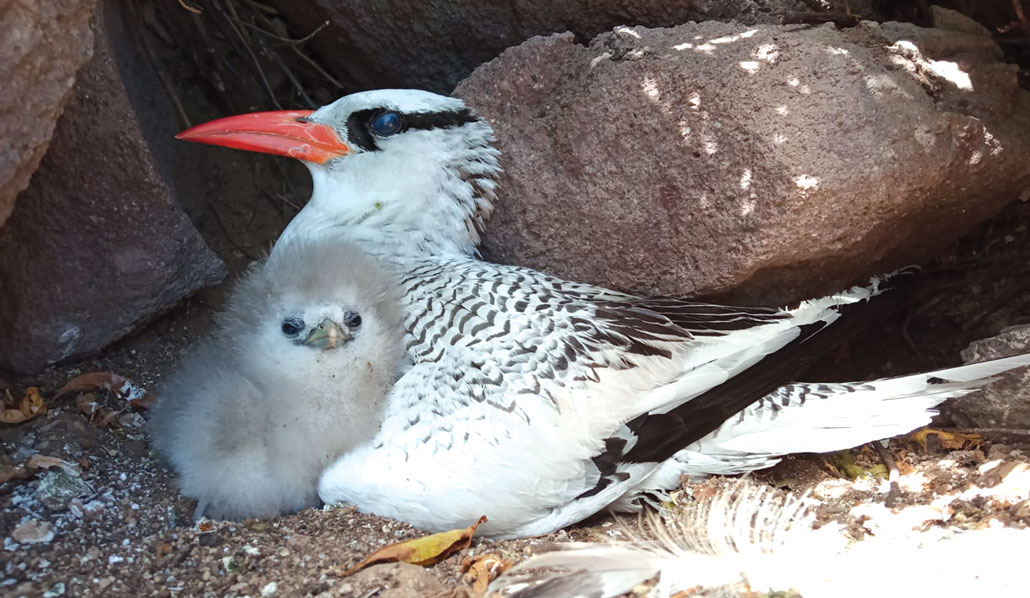
Madden and Mielke, working as an independent researcher, are now analyzing GPS data of the subspecies’s foraging patterns. The last Caribbean-wide assessment of seabirds happened over two decades ago, so Madden has been hosting webinars to teach people on other islands how to collect such data during next year’s nesting season.
“In 2023, we want people from as many islands as possible in the Caribbean to get out there and monitor the seabirds on their islands,” she says.
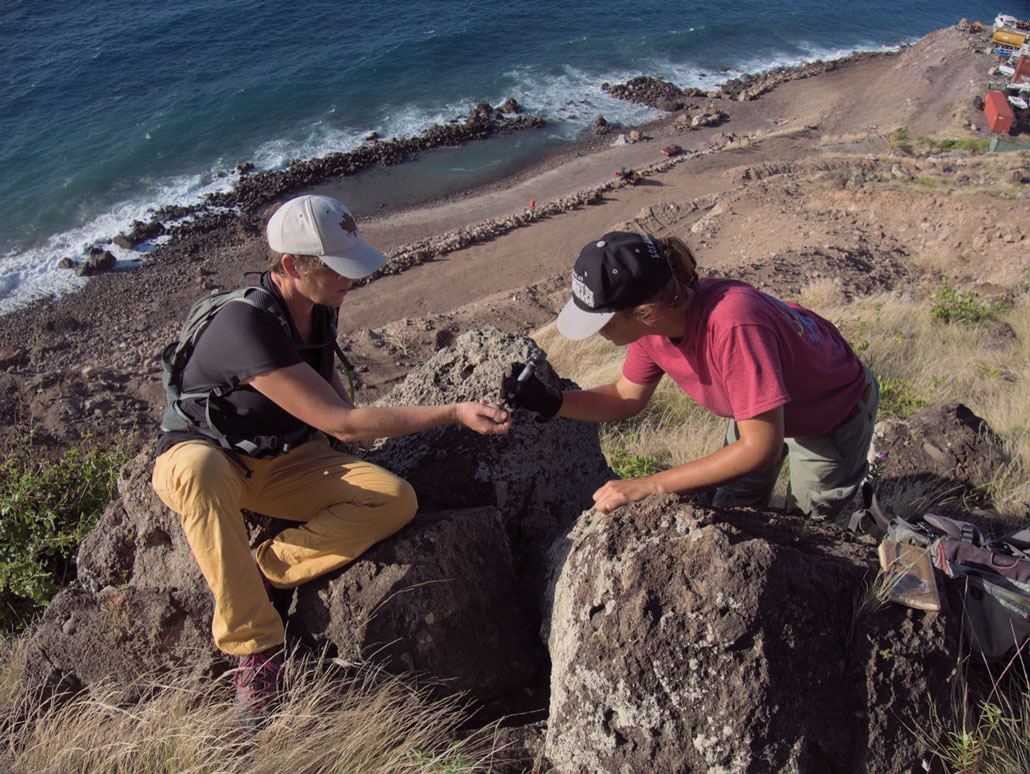
Hitting home
Peter Johnson, an 11th-generation Saba resident, teaches math and physics at the secondary school. Sometimes after class he sits outside the school and listens to the red-billed tropicbirds flying overhead.
“Their birdcall is so unique,” he says. “They’re certainly something that reminds me of home.”
Johnson was a kid when Sea & Learn started in 2003. He still remembers when, in the fifth grade, scientists came to his classroom and let him try on a spelunking helmet used for cave exploration. Years later, he returned to Saba after earning degrees in engineering in Virginia. “You’re more inclined to be proud of where you’re from, the more you know about it,” he says.
Esposito, of the Islands 2030 initiative, recalls being impressed by the fluency of Saban youth when talking about nature. Sea & Learn scientists visit Saba’s schools to teach about the island’s unique species. When Esposito asks students if they’ve seen the island’s local snake — its only snake, the red-bellied racer — they usually say yes. She doesn’t get the same answer on Statia or neighboring islands.
“I have seen the direct effect of Sea & Learn,” she says. “There is this connection between the people coming to do research and the local population and communities that doesn’t exist in most other places.”
Sea & Learn coordinator Emily Malsack hopes the program encourages locals to stay on Saba to work in conservation. It’s already having an impact. Johnson is now the president of the Saba Conservation Foundation. Saban native Dahlia Hassell-Knijff got a degree in biology in Mississippi, then returned to the island, where she oversees projects at the regional Dutch Caribbean Nature Alliance. She also grew up attending Sea & Learn.
“It was a very tiny organization [at the time], but it didn’t seem tiny to me,” Hassell-Knijff says. “It was like a dream come true for a little kid.”
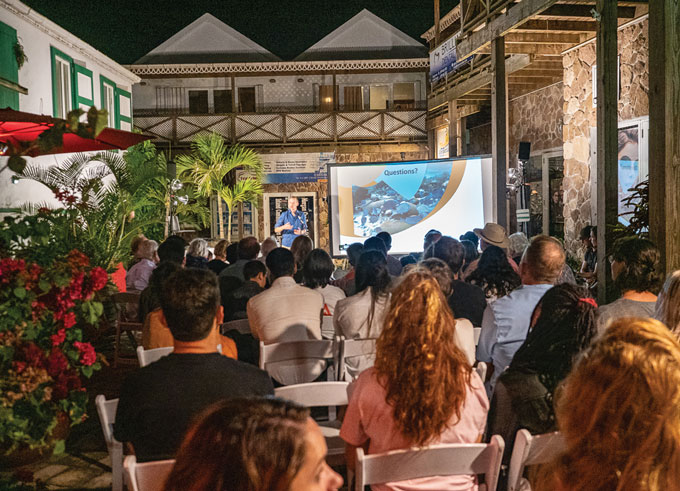
Hassell-Knijff’s story is “an indication of progress that’s to come,” Esposito says. Islands 2030 plans to recruit early-career scientists from five archipelagoes to attend the California Academy of Sciences in San Francisco, where they can work toward an advanced degree and become part of a network of scientists from their archipelago. The hope is that this next generation will return to their home islands to become leaders in biodiversity science and conservation.
There’s a need for this support. Many researchers who study island biology travel from abroad, spend some time and leave, causing research to sputter and disrupting long-term studies that are crucial to understanding population trends of, say, orchids and tropicbirds. Mielke recently ended her six months on Saba to return to Germany, and after 16 years on Statia, Madden moved back to the Netherlands this summer.
“It’s just tough,” Madden says. “At this point, I don’t know who will take over the projects that I’m working on.” Bechtold, too, worries about who will track the orchids after he and Boeken retire from research and can no longer travel to Saba.
Saving the urchins
The night that marine ecologist Alwin Hylkema presented his research about Diadema, the plaza was packed with over 100 adults and children. Hylkema has become something of a local celebrity. At first, he conducted his urchin research from the Netherlands, visiting Saba twice a year, until he realized it made more sense to do his studies on site. He moved his family to Saba in 2019.
Since then, Hylkema has worked on restoring Diadema to the reefs around Saba. But it’s a challenge: After urchin larvae settle onto a reef, they are easily eaten by queen triggerfish and spiny lobsters. To help more of the animals survive to adulthood, Hylkema’s team has been collecting the youngsters, known as settlers, and growing them in a lab on Saba. Once the animals are a few centimeters wide and less likely to become a meal, the team returns them to the reefs.
In October 2021, things were starting to look up for the animals. That same week, Hylkema’s team bred Diadema in captivity for the first time in Caribbean history.
The lab-grown urchin success came just in time. Hylkema anticipates producing 1,000 to 2,000 juveniles by the end of this year, which he hopes to use for restocking the devastated population at Diadema City. But that will have to wait until whatever is causing the die-off dissipates. Researchers at Cornell University are analyzing Diadema tissue sent by Hylkema and others to try to determine the cause, likely a pathogen.
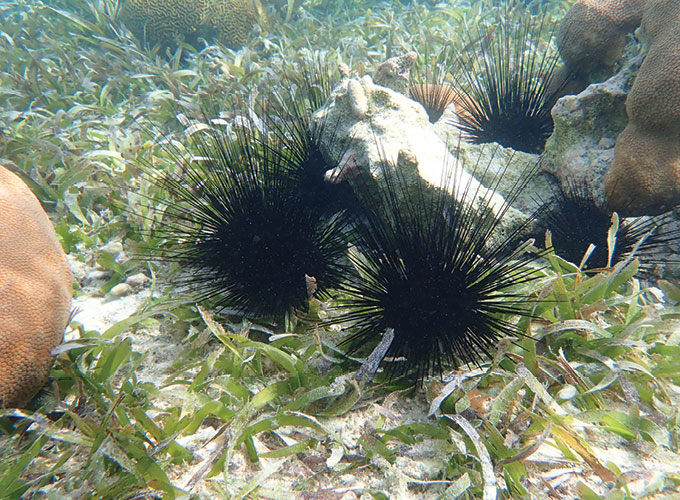
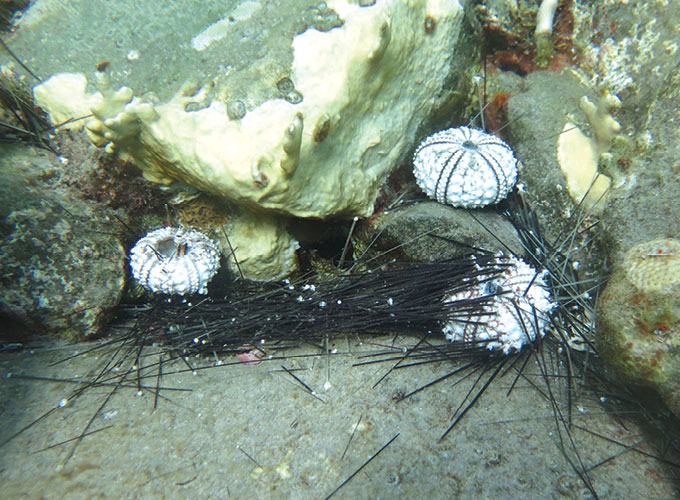
One afternoon, I hitchhiked south from the town of Windwardside in the middle of the island to the harbor in Fort Bay, where Hylkema’s lab is located. I wanted to see the captive-bred Diadema. The crates in the lab were organized by urchin size: The youngest ones looked like inch-long pom-poms; older urchins resembled plums covered in long, black sewing needles.
In an air-conditioned storage container out back, specks of urchin larvae swirled in glass jars on a vibrating metal plate. After 50 or so days, the larvae will settle and eventually be transferred to the crates. If all goes well, the animals will grow in the lab until they’re big enough to be taken out to the reefs, where they’ll begin the next generation of Diadema.






